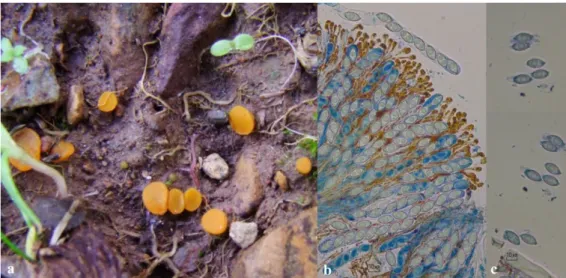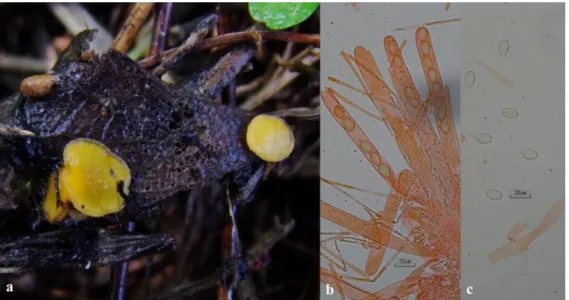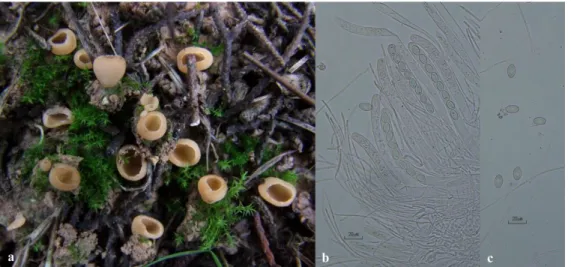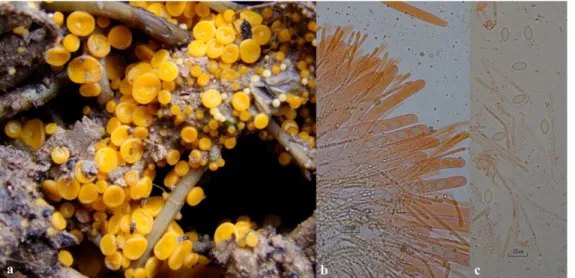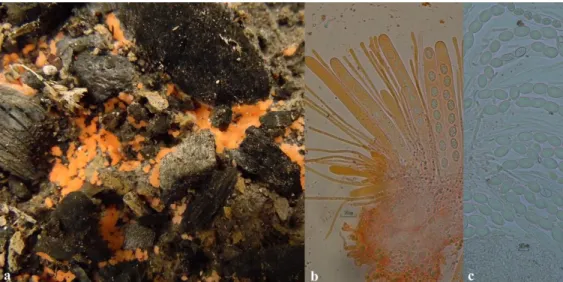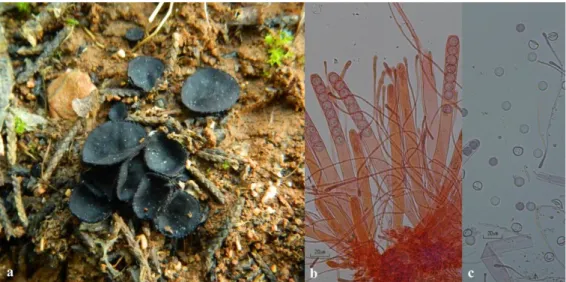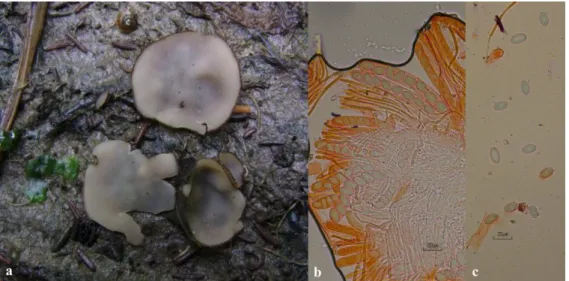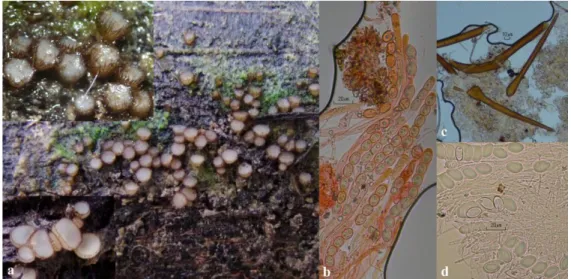http://journals.tubitak.gov.tr/botany/ © TÜBİTAK
doi:10.3906/bot-1508-4
Contributions to Turkish Pyronemataceae from Gaziantep Province
Abdullah KAYA1,*, Yasin UZUN1, İbrahim Halil KARACAN2, Semiha YAKAR11Department of Biology, Kâmil Özdağ Science Faculty, Karamanoğlu Mehmetbey University, Karaman, Turkey 2Ömer Özmimar Religious Anatolian High School, Gaziantep, Turkey
1. Introduction
Pyronemataceae is an ascomycetous fungal family within the order Pezizales, and represented by 43 members in Turkey (Solak et al., 2007, 2015; Sesli and Denchev, 2008; Akata and Kaya, 2013; Karacan et al., 2015; Kaya and Uzun, 2015). Thirteen of the 43 taxa currently exist in Gaziantep or neighboring provinces and 11 of them, Cheilymenia
theleboloides (Alb. & Schwein.) Boud., Hypotarzetta insignis
(Berthet & Riousset) Donadini, Pseudombrophila merdaria (Fr.) Brumm., Pulvinula archeri (Berk.) Rifai, P. carbonaria (Fuckel) Boud., P. laeterubra (Rehm) Pfister, Pustularia
patavina (Cooke & Sacc.) Boud., Pyronema omphalodes
(Bull.: Fr.) Fuckel, Scutellinia umbrorum (Fr.) Lambotte,
Sowerbyella rhenana (Fuckel) J. Moravec, and Tricharina gilva (Boud. ex Cooke) Eckblad, were determined for
the first time in Turkey within the boundaries of these provinces (Kaya, 2009a, 2009b, 2009c, 2015; Solak et al., 2014; Karacan et al., 2015; Kaya and Uzun, 2015).
Within the framework of an ongoing project aiming to determine the macrofungal diversity of Gaziantep Province some pyronemataceous macrofungi samples were collected and determined. Fourteen of them were found to be new for the mycobiota of Turkey: Aleuria
exigua Rifai; Cheilymenia catenipila J. Moravec; C. vitellina
(Pers.) Dennis; Geopyxis majalis (Fr.) Sacc.; G. vulcanalis (Peck) Sacc.; Humaria aurantia (Clem.) Häffner, Benkert & Krisai; Kotlabaea deformis (P. Karst.) Svrček; Pulvinula
johannis Lantieri; Pyronema domesticum (Sowerby)
Sacc.; Scutellinia trechispora (Berk. & Broome) Lambotte; Smardaea planchonis (Dunal ex Boud.) Korf & W.Y. Zhuang; Tricharina ochroleuca (Bres.) Eckblad;
Tricharina praecox (P. Karst.) Dennis; and Trichophaeopsis bicuspis (Boud.) Korf & Erb.
This study aims to make a contribution to the mycobiota of Turkey by adding new records.
2. Materials and methods
Fruiting bodies were collected from localities within the boundaries of Gaziantep Province in 2014 and 2015. Necessary morphological and ecological characteristics of the samples were recorded and they were photographed in their natural habitats. The samples were then taken to the laboratory for further investigations. Some macrostructural properties of smaller fruit bodies were investigated and photographed under an Olympus SZX7 trinocular stereomicroscope. Microstructural data were obtained and photographed under a Nikon eclipse Ci trinocular light microscope by DS-Fi2 digital camera with the help of a Nikon DS-L3 displaying apparatus. The samples were identified with the help of Seaver (1942), Hanlin (1965), Breitenbach and Kränzlin (1984), Yang and Korf (1985), Medardi (1991), Häffner and Benkert (1994), Sierra and Vila (1995), Benkert (2008), Lantieri (2008), and Raymundo et al. (2012) and are kept at Karamanoğlu Mehmetbey University, Faculty of Science, Department of Biology.
Abstract: Fourteen pyronemataceous macrofungi taxa (Aleuria exigua Rifai; Cheilymenia catenipila J. Moravec; Cheilymenia vitellina (Pers.) Dennis; Geopyxis majalis (Fr.) Sacc.; Geopyxis vulcanalis (Peck) Sacc.; Humaria aurantia (Clem.) Häffner, Benkert & Krisai;
Kotlabaea deformis (P. Karst.) Svrček; Pulvinula johannis Lantieri; Pyronema domesticum (Sowerby) Sacc.; Scutellinia trechispora (Berk.
& Broome) Lambotte; Smardaea planchonis (Dunal ex Boud.) Korf & W.Y. Zhuang; Tricharina ochroleuca (Bres.) Eckblad; Tricharina
praecox (P. Karst.) Dennis; and Trichophaeopsis bicuspis (Boud.) Korf & Erb) are given as new records for the mycobiota of Turkey from
Gaziantep Province. Three of them are the first members of the genera Kotlabaea Svrček, Smardaea Svrček, and Trichophaeopsis Korf & Erb in Turkey. Related photographs and short descriptions of the taxa are provided.
Key words: Biodiversity, Pyronemataceae, new records, Turkey
Received: 04.08.2015 Accepted/Published Online: 23.11.2015 Final Version: 08.04.2016
3. Results
The systematics of the newly recorded taxa are given in accordance with Cannon and Kirk (2007), Kirk et al. (2008), and the Index Fungorum (www.indexfungorum.org; accessed 31 July 2015). The taxa are listed in alphabetical order with a brief description, habitat, locality, collection date, and accession numbers.
3.1. Pyronemataceae Corda 3.1.1. Aleuria exigua Rifai
Verh. K. ned. Akad. Wet., tweede sect. 57 (3): 150 (1968) (Figure 1)
Macroscopic and microscopic features: Apothecia
2.5–5 mm across, subsessile, cup-shaped to smooth with an orange hymenium, outer surface paler, sometimes with whitish velar remnants at margin. Asci 170–200 × 9–12 µm, cylindrical, attenuated at the base. Paraphyses partitioned in the lower portion, 2–2.5 µm, clavate and
often slightly curved at apex. Spores 12–13 × 6.5–7 µm, elliptical, hyaline, usually with a large drop, sometimes with two guttules, walls may appear as regularly warty or reticularly ornamented.
Specimen examined: Gaziantep, İslahiye, Tandır
village, on soil among grass, 24.10.2014, 36°57′N, 36°29′E, 1130 m, K. 10137.
3.1.2. Cheilymenia catenipila J. Moravec
Acta Musei Moraviae, Sci. biolog. 88 (1/2): 48 (2003) (Figure 2)
Macroscopic and microscopic features: Apothecia
5–8 (9) mm across, sessile or firmly anchored to support with abundant whitish hyphae, gregarious. Pale orange to orange-ocher, outer surface concolorous with hymenium, hairs disappear when adult. Flesh very thin. Asci 120–150 × 10–12.5 µm, cylindrical, eight-spored. Paraphyses filiform, multiseptate, 2–2.6 µm in diameter, slightly enlarged at the
Figure 2. Cheilymenia catenipila: a- ascocarps, b- asci and paraphyses, c- spores. Figure 1. Aleuria exigua: a- ascocarps, b- asci and paraphyses, c- spores.
apex reaching up to 5–7 µm. Spores 12–15 × 6–6.5 µm, hyaline, ellipsoid to almost cylindrical.
Specimen examined: İslahiye, Tandır village, Huzurlu
high plateau, on cow dung, 36°57′N, 36°29′E, 1120 m, 26.04.2014, K. 8897.
3.1.3. Cheilymenia vitellina (Pers.) Dennis
British Cup Fungi & Their Allies: 27 (1960) [Syn. Ciliaria
vitellina (Pers.) Boud., Humaria vitellina (Pers.) Quél., Lachnea vitellina (Pers.) Sacc., Peziza vitellina Pers., Peziza vitellina subsp. sabulosa Pers., Peziza vitellina Pers., subsp. vitellina, Sarcoscypha vitellina (Pers.) Cooke, Scutellinia vitellina (Pers.) Lambotte] (Figure 3)
Macroscopic and microscopic features: Apothecia
5–14 mm across, saucer-shaped to subglobose, then discoid with wavy or lobed margin, sessile. Hymenium pale to sulfur yellow, margin and outer surface sparsely covered with inconspicuous pale yellow bristle-like hairs.
Asci 180–200 × 12–14 µm, cylindrical, eight-spored. Paraphyses cylindrical, 2–3 µm, somewhat thickening above. Spores 15–16 × 7.5–8 µm, ellipsoid, hyaline, smooth. Hairs 400–600 × 15–30 µm, yellowish brown, thick-walled, with tuberous and multiseptate base.
Specimen examined: Karkamış, Yurtbağı village, on
rotten herb, 36°50′N, 38°00′E, 330 m, 25.10.2014, K. 10204.
3.1.4. Geopyxis majalis (Fr.) Sacc.
Syll. fung. (Abellini) 8: 72 (1889) [Syn. Peziza majalis Fr.] (Figure 4)
Macroscopic and microscopic features: Apothecia 10–
30 mm across, cupuliform. Hymenium smooth, orange to salmon pink, margin whitish and crenate, outer surface pale orange. Asci 180–200 × 9–10 µm, hyaline, clavate, eight-spored. Paraphyses threadlike, 1.5–2.5 µm, septate, sometimes branched at the base, some forked at the apex. Spores 17–19 × 7–9 µm, broadly elliptical, thick-walled.
Figure 4. Geopyxis majalis: a- ascocarps, b- asci and paraphyses, c- spores. Figure 3. Cheilymenia vitellina: a- ascocarps, b- asci and paraphyses, c- spores.
Specimen examined: İslahiye, Kozdere village, on soil,
37°07′N, 36°39′E, 585 m, 21.03.2015, K. 11450; Altınüzüm village, on soil, 36°54′N, 36°33′E, 480 m, 21.03.2015, K. 11468.
3.1.5. Geopyxis vulcanalis (Peck) Sacc.
1889 (Figure 5)
Macroscopic and microscopic features: Apothecia
4–10 mm across, deeply cup-shaped when young, often flattening when old, pale orange to pale or yellowish, outer surface paler, usually with a short stem up to 5 mm long. Asci 230–260 × 15–17 µm, cylindrical, eight-spored. Paraphyses slightly thickened in upper part up to 4 µm. Spores 14–21 × 8–11 µm, elliptical, smooth.
Specimen examined: Nizip, Sekili village, cemetery,
on soil, 36°58′N, 37°40′E, 600 m, 13.12.2014, K. 11077; Oğuzeli, center, cemetery, 36°57′N, 37°30′E, 670 m, 08.03.2015, K. 11420; Nurdağı, Olucak village, roadside, on soil, 20.03.2015, 37°10′N, 36°40′E, 950 m, K. 11434;
İslahiye, Kozdere village, cemetery, on soil, 37°06′N, 36°39′E, 565 m, 28.03.2015, K. 11529.
3.1.6. Humaria aurantia (Clem.) Häffner, Benkert & Krisai
Öst. Z. Pilzk. 3: 84 (1994) [Syn. Lachnea aurantia (Clem.) Clem., Scutellinia aurantia (Clem.) Waraitch, Sepultaria
aurantia Clem.] (Figure 6)
Macroscopic and microscopic features: Apothecia
5–22 mm across, hemispherical to deep cup-shaped when young, spread when old, sessile. Pale yellow to ocher yellow or bright orange to brownish orange. Asci 200–250 × 8–12 µm, cylindrical, operculate, eight-spored. Paraphyses slender, septate, forked, slightly thickened in upper part up to 3.5-4.5 µm. Spores 15–17.5 × 7.5–9 µm, elliptical, smooth, hyaline, usually with a central drop.
Specimen examined: Şehitkâmil, cemetery, on dead
branches of Cupressus sempervirens L., 37°04′N, 37°23′E, 845 m, 06.03.2015, K. 11375.
Figure 6. Humaria aurantia: a- ascocarps, b- asci and paraphyses, c- spores. Figure 5. Geopyxis vulcanalis: a- ascocarps, b- asci and paraphyses, c- spores.
3.1.7. Kotlabaea deformis (P. Karst.) Svrček
Česká Mykol. 23: 87 (1969) [Syn. Humaria callichroa Boud.,
Humaria deformis (P. Karst.) Sacc., Humarina deformis (P.
Karst.) Nannf., Inermisia deformis (P. Karst.) Dennis & Itzerott, Neottiella callichroa (Boud.) Sacc., Octospora
callichroa (Boud.) Arpin, Octospora deformis (P. Karst.)
Gamundí, Peziza deformis P. Karst., Pyronema deforme (P. Karst.) Rehm.] (Figure 7)
Macroscopic and microscopic features: Apothecia
1–3 mm across, initially spherical then hemispherical to cup-shaped when young, flattens when old having a hardly deepened disc shape. Orange yellow to bright orange. Asci 200–230 × 12–14 µm, cylindrical, eight-spored. Paraphyses slender, straight, filled with red or paler drops, some slightly expanded in upper part up to 4–5 µm. Spores 14– 17 × 8–10 µm, ellipsoidal, smooth, usually filled by small droplets, sometimes with additional 1–3 larger drops.
Specimen examined: Oğuzeli, center, roadside, on
damp soil, 36°58′N, 37°30′E, 700 m, 13.12.2014, K. 11072.
3.1.8. Pulvinula johannis Lantieri
Sydowia 60(2): 248 (2008) (Figure 8)
Macroscopic and microscopic features: Apothecia
3–5 mm, irregularly cup-shaped when young, then saucer-shaped and almost flattened when old. Usually densely aggregated. Hymenium pale or more or less pink salmon, outer surface concolorous or slightly paler. Asci 160–190 × 12–14 µm, cylindrical with a forked base, eight-spored. Paraphyses 1–1.5 µm wide, slender, remarkably longer than asci, curved or hooked at upper part with small oil drops. Spores 9–11 µm in diameter, spherical, usually with a large oil drop.
Specimen examined: İslahiye, Kozdere village,
cemetery, on soil among moss, 37°07′N, 36°39′E, 585 m, 21.03.2015, K. 11444.
Figure 7. Kotlabaea deformis: a- ascocarps, b- asci and paraphyses, c- spores.
3.1.9. Pyronema domesticum (Sowerby) Sacc.
Syll. fung. (Abellini) 8: 109 (1889) [Syn. Peziza
domestica Sowerby, Pyronema domesticum (Sowerby) Sacc.
var. domesticum, Pyronema domesticum var. raatzii Henn.,
Tapesia domestica (Sowerby) Quél.] (Figure 9)
Macroscopic and microscopic features: Apothecia
0.5–2 mm across, sessile, disciform pulvinate, forms a mass of few square cm to few square dm and resides on a white surface mycelium. Hymenium usually convex, pink-red with an almost smooth margin. Asci 150–160 × 12–15 µm, almost cylindrical. Paraphyses cylindrical, with some septa, slightly enlarged at the apex up to 3–4 µm. Spores 15–16 × 10–11 µm, elliptical, smooth, hyaline.
Specimen examined: Karkamış, Yurtbağı village, near
the road, on ash, 36°50′N, 38°00′E, 330 m, 25.10.2014, K. 10219; Şahinbey, Yeşilce village, on ash, 37°10′N, 37°12′E, 1045 m, 16.11.2014, K. 10703.
3.1.10. Scutellinia trechispora (Berk. & Broome) Lambotte
Mém. Soc. roy. Sci. Liège, Série 2 14: 299 (prepr.) (1887) [Syn. Ciliaria trechispora (Berk. & Broome) Boud., Ciliaria
trechispora (Berk. & Broome) Boud. var. trechispora, Humaria trechispora (Berk. & Broome) P. Karst., Lachnea hirta var. trechispora (Berk. & Broome) Petr., Lachnea trechispora
(Berk. & Broome) Gillet, Peziza trechispora Berk. & Broome,
Rubelia trechispora (Berk. & Broome) Nieuwl., Scutellinia trechispora f. brachyacantha Le Gal, Scutellinia trechispora
(Berk. & Broome) Lambotte f. trechispora, Scutellinia
trechispora var. macracantha Le Gal ex Donadini, Scutellinia trechispora var. nardii Le Gal, Scutellinia trechispora var. peniculospora Donadini, Scutellinia trechispora (Berk. &
Broome) Lambotte var. trechispora, Sphaerospora trechispora (Berk. & Broome) Sacc., Sphaerospora trechispora (Berk. & Broome) Sacc. f. trechispora, Sphaerospora trechispora (Berk. & Broome) Sacc. var. trechispora, Sphaerosporula trechispora (Berk. & Broome) Kuntze] (Figure 10)
Figure 10. Scutellinia trechispora: a- ascocarps, b- asci, paraphyses, and spores in asci. Figure 9. Pyronema domesticum: a- ascocarps, b- asci and paraphyses, c- spores.
Macroscopic and microscopic features: Apothecia
3–10 mm across, disc-shaped. Hymenium smooth, red orange to deep red with differential margin, outer surface and margin covered with long dark brown hairs. Asci 220– 310 × 27–36 µm, cylindrical, eight-spored. Paraphyses cylindrical, straight, septate, slightly enlarged at the apex up to 7-9 µm. Hairs up to 750 µm, brown, thick-walled, multiply septate. Spores 15.5–17 × 15–16, with a large guttule, covered entirely with evenly distributed truncated conical spines.
Specimen examined: Nurdağı, Olucak village, on
sludge soil, 37°10′N, 36°40′E, 950 m, 10.04.2015, K. 11686.
3.1.11. Smardaea planchonis (Dunal ex Boud.) Korf & W.Y. Zhuang
Mycotaxon 40: 427 (1991) [Syn. Barlaea planchonis (Dunal ex Boud.) Sacc., Barlaeina planchonis (Dunal ex Boud.) Sacc. & Traverso, Greletia planchonis (Dunal ex Boud.) Donadini, Lamprospora planchonis (Dunal ex Boud.) Seaver, Lamprospora planchonis (Dunal ex Boud.) Seaver var. planchonis, Marcelleina planchonis (Dunal ex Boud.) J. Moravec, Plicaria planchonis Dunal ex Boud., Plicaria
planchonis Dunal ex Boud. var. planchonis, Pulparia planchonis (Dunal ex Boud.) Korf, Pfister & J.K. Rogers, Pulparia planchonis (Dunal ex Boud.) Korf, Pfister & J.K.
Rogers f. planchonis, Pulparia planchonis (Dunal ex Boud.) Korf, Pfister & J.K. Rogers var. planchonis] (Figure 11)
Macroscopic and microscopic features: Apothecia
7–16 mm across, disc-shaped when young, shallowly concave or flat when mature, subsessile to sessile, anchored to the soil by a rhizoidal system. Hymenium smooth, dark blue purple, outer surface finely warted. Asci 180–220 × 12–14 µm, cylindrical, tapering at the base, operculate. Paraphyses slender, 2–3 µm, slightly longer than asci, septate, with clavate tips. Spores 10–13 µm, spherical,
smooth, hyaline when young, becoming pale purple at maturity.
Specimen examined: Nizip, Sekili village, cemetery,
on soil, 36°58′N, 37°40′E, 600 m, 13.12.2014, K. 11078; Şahinbey, center, roadside, on soil, 37°03′N, 37°21′E, 865 m, 03.01.2015, K. 11123; Şehitkâmil, cemetery, on soil, 37°04′N, 37°23′E, 845 m, 04.01.2015, K. 11163; Oğuzeli, cemetery, on soil, 36°57′N, 37°30′E, 670 m, 08.03.2015, K. 11418.
3.1.12. Tricharina ochroleuca (Bres.) Eckblad
Nytt Mag. Bot. 15(1–2): 61 (1968) [Syn. Ascorhizoctonia
ochroleuca Chin S. Yang & Korf, Lachnea ochroleuca
(Bres.) Sacc., Pellicularia ochroleuca (Bres.) D.P. Rogers,
Peziza ochroleuca Bres., Tricharia ochroleuca (Bres.)
Boud.] (Figure 12)
Macroscopic and microscopic features: Apothecia
3–12 mm across, saucer-shaped to flat, slightly embedded in the ground when young. Hymenium smooth, ochraceous to grayish pale brown, margin with many fasciculate hairs. Asci 200–220 × 19–21 µm, eight-spored. Paraphyses filiform, 2.5–4 µm, septate. Hairs brown, thick-walled, multiply septate. Spores 15–18 × 8–10 µm, broadly elliptical, hyaline, smooth.
Specimen examined: Nurdağı, Kömürler village,
cemetery, on soil, 37°09′N, 36°48′E, 535 m, 03.04.2015, K. 11587; Atmalı village, cemetery, on soil, 37°08′N, 36°52′E, 620 m, 12.04.2015, K. 11725.
3.1.13. Tricharina praecox (P. Karst.) Dennis
Kew Bull. 25(2): 338 (1971) [Syn. Ascorhizoctonia
praecox Chin S. Yang & Korf, Humaria praecox (P. Karst.) P.
Karst., Lachnea praecox (P. Karst.) Sacc., Peziza praecox P. Karst., Tricharina praecox var. intermedia Egger, Chin S. Yang & Korf, Tricharina praecox (P. Karst.) Dennis var.
praecox] (Figure 13)
Macroscopic and microscopic features: Apothecia 2–6
mm across, deeply cupulate when young then saucer-shaped to flat, somewhat undulating, sessile, slightly embedded in the substrate, Hymenium smooth, ochraceous to brownish, margin with many fasciculate hairs. Asci 190–200 × 19–22 µm, cylindrical, tapering at the base, eight-spored. Paraphyses 3.5–5 µm in diameter, septate, sometimes forked. Hairs up to 160 µm, hyaline to pale brown, multiply septate. Spores 14–16 × 8–10 µm, broadly elliptical, hyaline, smooth, with small granules at the ends.
Specimen examined: Şahinbey, center, Ömer Özmimar
Religious Anatolian High School garden, 37°03′N, 37°21′E, 865m, 24.12.2014, K. 11118.
3.1.14. Trichophaeopsis bicuspis (Boud.) Korf & Erb
Phytologia 24(1): 18 (1972) [Syn. Ciliaria
bicuspis Boud., Lachnea bicuspis (Boud.) Sacc. & P.
Syd., Lachnea eichleri Bres., Lachnella setiformis Rehm,
Trichophaea bicuspis (Boud.) Boud., Trichophaea eguttulispora Gamundí, Trichophaeopsis bicuspis (Boud.)
Korf & Erb subsp. bicuspis, Trichophaeopsis bicuspis subsp.
eguttulispora (Gamundí) Korf.] (Figure 14)
Macroscopic and microscopic features: Apothecia 3–7
mm across, saucer-shaped to flat or plate shaped, resting stalkless on the substrate. Hymenium smooth, gray-white, margin with a dark ring, outer surface ciliated with well-separated long brown bristles. Asci 215–245 × 12–15 µm, eight-spored. Paraphyses filiform, 1.5–2 µm wide, multiply septate. Hairs brown, thick-walled, multiply septate. Spores 14–16 × 11–12 µm, broadly elliptical, hyaline, smooth, with small groups of little drops.
Specimen examined: Oğuzeli, center, on dead stump
of poplar, 36°58′N, 37°30′E, 700 m, 13.12.2014, K. 11064; Şehitkâmil, cemetery, on dead branches of Salix sp, 37°04′N, 37°23′E, 845 m, 04.01.2015, K. 11151.
Figure 12. Tricharina ochroleuca: a- ascocarps, b- asci and paraphyses, c- spores.
4. Discussion
Currently 43 pyronemataceous macrofungi taxa belonging to 25 genera exist in Turkey (Solak et al., 2007, 2015; Sesli and Denchev, 2008; Akata and Kaya, 2013; Karacan et al., 2015; Kaya and Uzun, 2015). Among them, Otidea (Pers.) Bonord. is the most diverse one with 5 taxa. Geopora Harkn. and Scutellinia (Cooke) Lambotte are represented with 4 taxa; Genea Vittad. and Pulvinula Boud. are represented with 3 taxa; Cheilymenia Boud., Melastiza Boud., Tarzetta (Cooke) Lambotte, and Trichophaea Boud. are represented with 2 taxa; and the rest of them are represented with one taxon.
With this study, 14 taxa are added to the Turkish Pyronemataceae. Three of them, Kotlabaea Svrček,
Smardaea Svrček, and Trichophaeopsis Korf & Erb, are
new at the genus level. As a result, the genus and species numbers of pyronemataceous fungi in Turkey increased to 28 and 57, respectively. In general, all of the determined characteristics of the newly recorded taxa are in agreement with those given in literature.
Aleuria exigua is the second member of the genus to be
recorded from Turkey (Sesli and Denchev, 2008). Members of the genera Aleuria Fuckel and Octospora Hedw. may have some morphological similarities, but Octospora species may easily be distinguished from Aleuria due to their association with bryophyte substrates.
Cheilymenia catenipila is a quite particular species,
characterized by the shape of its hairs. Though it is the second taxa of the section Obtusipilosae together
Cheilymenia magnifica (W.Y. Zhuang & Korf) J. Moravec,
it differs from the latter by smaller spores and shorter hairs. Both of them may probably be confused with some Pseudombrophila Boud. species, but they differ by the absence of intercellular dark pigments from the hair (Rubio and Delpont, 2014).
Cheilymenia vitellina is easily recognized by its
large yellow apothecia, relatively long and strong, and predominantly terrestrial habitat. Together with
Cheilymenia theleboloides (Alb. & Schwein.) Boud., C. vitellina differs from the other members of the genus with
its excipular structure and pale, inconspicuous, superficial hairs (Al-anbagi, 2014). Al-anbagi (2014) stated that this group of species is very closely related to the genus
Coprobia Boudier, and further study of the genus Coprobia
may lead to its merging with Cheilymenia Boud., or possibly to the transfer of these species from Cheilymenia to Coprobia.
The only existing member of the genus Geopyxis (Pers.) Sacc. in Turkey is Geopyxis carbonaria (Alb. & Schwein.) Sacc., and it is similar to Geopyxis majalis in terms of morphology. It is separated from the latter species by its brownish apothecia, its distinct habitat of burned places, and smaller spores (Uzun et al., 2010).
Pulvinula johannis resembles P. archeri (Berk.) Rifai
in terms of apothecial shape, but it differs from the latter species with its pale or more or less pink salmon hymenial color and larger asci and ascospores. Pulvinula laeterubra (Rehm) Pfister also has similar-sized apothecia to those of
P. johannis, but its larger ascospores differentiate the two
species from each other (Karacan et al, 2015).
Pyronema domesticum is similar to P. omphalodes
(Bull.: Fr.) Fuckel in terms of occurrence on burned ground and closely compressed and formless manner of growth. However, the former has larger spores and more reddish color (Breitenbach and Kränzlin, 1984).
Acknowledgment
The authors would like to thank TÜBİTAK for supporting the project (212T112) financially.
References
Akata I, Kaya A (2013). Three pyronemataceous macrofungi genera, new to Turkey. Turk J Bot 37: 977–980.
Al-anbagi RA (2014). Histological study of the Discomycetes fungus Cheilymenia theleboloides. Journal of Babylon University/Pure and Applied Sciences 22: 769–778.
Benkert D (2008). Emendation der Gattung Kotlabaea (Ascomycota, Pezizales). Österr Z Pilzk 17: 173–221 (in German).
Breitenbach J, Kränzlin F (1984). Fungi of Switzerland. Vol. 1. Luzern, Switzerland: Verlag Mykologia.
Cannon PF, Kirk PM (2007). Fungal Families of the World. Wallingford, UK: CAB International.
Häffner J, Benkert D (1994). Humaria aurantia, ein seltener und auffälliger Discomycet des Auwaldes. Ost Zeitschr f Pilzk 3: 77–85 (in German).
Hanlin RT (1965). Lamprospora planchonis from Georgia. Mycologia 57: 131–134.
Karacan İH, Uzun Y, Kaya A, Yakar S (2015). Pulvinula Boud., a new genus and three pulvinuloid macrofungi taxa new for Turkey. Biological Diversity and Conservation 8: 161–164.
Kaya A (2009a). Macromycetes of Kahramanmaraş Province (Turkey). Mycotaxon 108: 31–34.
Kaya A (2009b). Macrofungal diversity of Adıyaman Province (Turkey). Mycotaxon 108: 31–34.
Kaya A (2009c). Macrofungi of Huzurlu high plateau (Gaziantep-Turkey). Turk J Bot 33: 429–437.
Kaya A (2015). Contributions to the macrofungal diversity of Atatürk Dam Lake basin. Turk J Bot 39: 162–172.
Kaya A, Uzun Y (2015). Six new genus records for Turkish Pezizales from Gaziantep Province. Turk J Bot 39: 506–511.
Kirk PM, Cannon PF, Minter DW, Stalpers JA (2008). Dictionary of the Fungi. 10th ed. Wallingford, UK: CAB International.
Lantieri A (2008). Pulvinula johannis, a new species from Sicily, Italy. Sydowia 60: 247–252.
Medardi G (1991). I funghi del genere Pyronema Carus 1835. Rivista di Micologia 34: 72–76 (in Italian).
Raymundo T, Bautista-Hernandez S, Aguirre-Acosta E, Aguilar S, Valenzuela R (2012). Nuevos registros de Pezizales (Pezizomycetes, Ascomycota) en Mexico. Bol Soc Micol Madrid 36: 13–21 (in Spanish).
Rubio E, Delpont M (2014). Cheilymenia catenipila J. Moravec (Pezizales) Un rare discomycète coprophile découvert en Espagne et en France. Ascomycete.org 6: 11–16 (in French).
Seaver FJ (1942). The North American Cup-Fungi (Operculates). Supplementary Edition. New York, NY, USA: Seaver.
Sesli E, Denchev CM. (2014). Checklists of the Myxomycetes, Larger Ascomycetes, and Larger Basidiomycetes in Turkey. Available online at http://www.mycotaxon.com/resources/weblists.html. Sierra D, Vila IJ (1995). Notas sobre Ascomicetes II: Trichophaea
boudieri Grelet y Trichophaeopsis biscuspis (Boud.) Korf & Erb, en Catalunya. Revista Soc Catalana Micol 18: 151–156 (in Catalan).
Solak MH, Allı H, Işıloğlu M, Güngör H, Kalmış E (2014). Contributions to the macrofungal diversity of Kilis Province. Turk J Bot 38: 180–185.
Solak MH, Işıloğlu M, Kalmış E, Allı H (2007). Macrofungi of Turkey, Checklist, Vol. I. İzmir, Turkey: Üniversiteliler Ofset (in Turkish).
Solak MH, Işıloğlu M, Kalmış E, Allı H (2015). Macrofungi of Turkey, Checklist, Vol. II. İzmir, Turkey: Üniversiteliler Ofset (in Turkish).
Uzun Y, Demirel K, Kaya A, Gücin F (2010). Two new genus records for Turkish mycota. Mycotaxon 111: 477–480.
